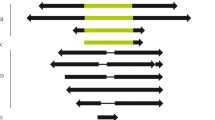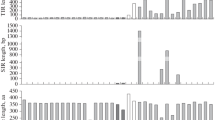Abstract
The genome of Drosophila bifasciata harbours two distinct subfamilies of P-homologous sequences, designated M-type and O-type elements based on similarities to P element sequences from other species. Both subfamilies have some general features in common: they are of similar length (M-type: 2935 bp, O-type: 2986 bp), are flanked by direct repeats of 8 by (the presumptive target sequence), contain terminal inverted repeats, and have a coding region consisting of four exons. The splice sites are at homologous positions and the exons have the coding capacity for proteins of 753 amino acids (M-type) and 757 amino acids (O-type). It seems likely that both types of element represent functional transposons. The nucleotide divergence of the two P element subfamilies is high (31%). The main structural difference is observed in the terminal inverted repeats. Whereas the termini of M-type elements consist of 31 by inverted repeats, the inverted repeats of the O-type elements are interrupted by non-complementary stretches of DNA, 12 by at the 5′ end and 14 by at the 3′ end. This peculiarity is shared by all members of the O-type subfamily. Comparison with other P element sequences indicates incongruities between the phylogenies of the species and the P transposons. M-type and O-type elements apparently have no common origin in the D. bifasciata lineage. The M-type sequence seems to be most closely related to the P element from Scaptomyza pallida and thus could be considered as a more recent invader of the D. bifasciata gene pool. The origin of the O-type elements cannot be unequivocally deduced from the present data. The sequence comparison also provides new insights into conserved domains with possible implications for the function of P transposons.
Similar content being viewed by others
References
Anxolabéhère D, Kidwell MG, Periquet G (1988) Molecular characteristics of diverse populations are consistent with the hypothesis of a recent invasion of Drosophila melanogaster by mobile P elements. Mol Biol Evol 5:252–269
Beverley SM, Wilson AC (1984) Molecular evolution in Drosophila and the higher Diptera II. A time scale for fly evolution. J Mol Evol 21:1–13
Bingham PM, Kidwell MG, Rubin GM (1982) The molecular basis of P-M hybrid dysgenesis: the role of the P element, a P-strain-specific transposon family. Cell 29:995–1004
Brookfield JFK, Montgomery E, Langley CH (1984) Apparent absence of transposable elements related to the P elements of Drosophila melanogaster in other species of Drosophila. Nature 310:330–332
Daniels SB, Peterson KR, Strausbaugh LD, Kidwell MG, Chovnick A (1990) Evidence for horizontal transmission of the P transposable element between Drosophila species. Genetics 124:339–355
Engels WR (1989) P elements in Drosophila melanogaster. In: Berg DE, Howe MM (eds) Mobile DNA. American Society for Microbiology, Washington, pp 437–484
George DG, Barker WC, Hunt LT (1990) Mutation data matrix and its uses. Methods Enzymol 183:333–351
Geyer PK, Green MM, Corces VG (1988) Mutant gene phenotypes mediated by a Drosophila melanogaster retrotransposon require sequences homologous to mammalian enhancers. Proc Natl Acad Sci USA 85:8593–8597
González AM, Hernandez M, Volz A, Pestano J, Larruga JM, Sperlich D, Cabrera VM (1990) Mitochondrial DNA evolution in the obscura species subgroup of Drosophila. J Mol Evol 31:122–131
Hagemann S, Miller WJ, Pinsker W (1990) P-related sequences in Drosophila bifasciata: a molecular clue to the understanding of P-element evolution in the genus Drosophila. J Mol Evol 31:478–484
Hagemann S, Miller WJ, Pinsker W (1992) Identification of a complete P-element in the genome of Drosophila bifasciata. Nucleic Acids Res 20:409–413
Higgins DG, Bleasby AJ, Fuchs R (1992) CLUSTAL V: improved software for multiple sequence alignment. Cabios 8:189–191
Houk MA, Clark JB, Peterson KR, Kidwell MG (1991) Possible horizontal transfer of Drosophila genes by the mite Proctolaelaps regalis. Science 253:1125–1129
Hurst GD, Hurst LD, Majerus MEN (1992) Selfish genes move sideways. Nature 356:659–660
Kaufman PD, Doll RF, Rio DC (1989) Drosophila P element transposase recognizes internal P element DNA sequences. Cell 59:359–371
Kidwell MG (1992) Horizontal transfer of P elements and other short inverted repeat transposons. Genetica 86:275–286
Kidwell MG, Kidwell JF, Sved JA (1977) Hybrid dysgenesis in Drosophila melanogaster: a syndrome of aberrant traits including mutation, sterility and male recombination. Genetics 86:813–833
Kimura M (1983) The neutral theory of molecular evolution. Cambridge University Press, Cambridge
Lansman RA, Shade RO, Grigliatti TA, Brock HW (1987) Evolution of P transposable elements: sequences of Drosophila nebulosa P elements. Proc Natl Acad Sci USA 84:6491–6495
Loukas M, Krimbas CB, Vergini Y (1984) Evolution of the obscura group Drosophila species. II. Phylogeny of ten species based on electrophoretic data. Heredity 53:483–493
Miller WJ, Hagemann S, Reiter E, Pinsker W (1992) P homologous sequences are tandemly repeated in the genome of Drosophila guanche. Proc Natl Acad Sci USA 89:4018–4022
Mount SM, Green MM, Rubin GM (1988) Partial revertants of the transposable element-associated suppressible allele white-apricot in Drosophila melanogaster: structures and responsiveness to genetic modifiers. Genetics 118:221–234
O'Hare K, Rubin GM (1983) Structures of P transposable elements and their sites of insertion and excision in the Drosophila melanogaster genome. Cell 34:25–35
Paricio N, Perez-Alonso M, Martinez-Sebastian MJ, DeFrutos R (1991) P sequences of Drosophila subobscura lack exon 3 and may encode a 66 kd repressor-like protein. Nucleic Acids Res 19:6713–6718
Perkins HD, Howells AJ (1992) Genomic sequences with homology to the P element of Drosophila melanogaster occur in the blowfly Lucilia cuprina. Proc Natl Acad Sci USA 89:10753–10757
Rio DC (1990) Molecular mechanisms regulating Drosophila P element transposition. Annu Rev Genet 24:543–578
Rio DC, Laski FA, Rubin GM (1986) Identification and immunochemical analysis of biologically active Drosophila P element transposase. Cell 44:21–32
Saitou N, Nei M (1987) The neighbor-joining method: a new method for reconstructing phylogenetic trees. Mol Biol Evol 4:406–425
Sambrook J, Fritsch EF, Maniatis T (1989) Molecular cloning: a laboratory manual, 2nd edn. Cold Spring Harbor Laboratory Press, Cold Spring Harbor, New York
Sanger F, Nicklen S, Coulson AR (1977) DNA sequencing with chain-terminating inhibitors. Proc Natl Acad Sci USA 74:5463–5467
Simonelig M, Anxolabéhère D (1991) A P element of Scaptomyza pallida is active in Drosophila melanogaster. Proc Natl Acad Sci USA 88:6102–6106
Throckmorton LH (1975) The phylogeny, ecology and geography of Drosophila. In: King R (ed) Handbook of genetics, vol 3: Invertebrates of genetic interest. Plenum, New York, pp 421–469
Tower J, Karpen GH, Craig N, Spradling AC (1993) Preferential transposition of Drosophila P elements to nearby chromosomal sites. Genetics 133:347–359
Zhang P, Spradling AC (1993) Efficient and dispersed local P element transposition from Drosophila females. Genetics 133:361–373
Author information
Authors and Affiliations
Additional information
Communicated by M. Ashburner
Rights and permissions
About this article
Cite this article
Hagemann, S., Miller, W.J. & Pinsker, W. Two distinct P element subfamilies in the genome of Drosophila bifasciata . Molec. Gen. Genet. 244, 168–175 (1994). https://doi.org/10.1007/BF00283519
Received:
Accepted:
Issue Date:
DOI: https://doi.org/10.1007/BF00283519




